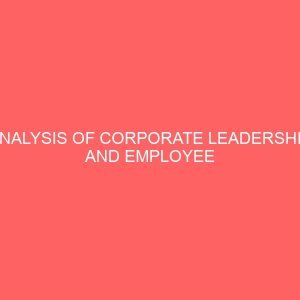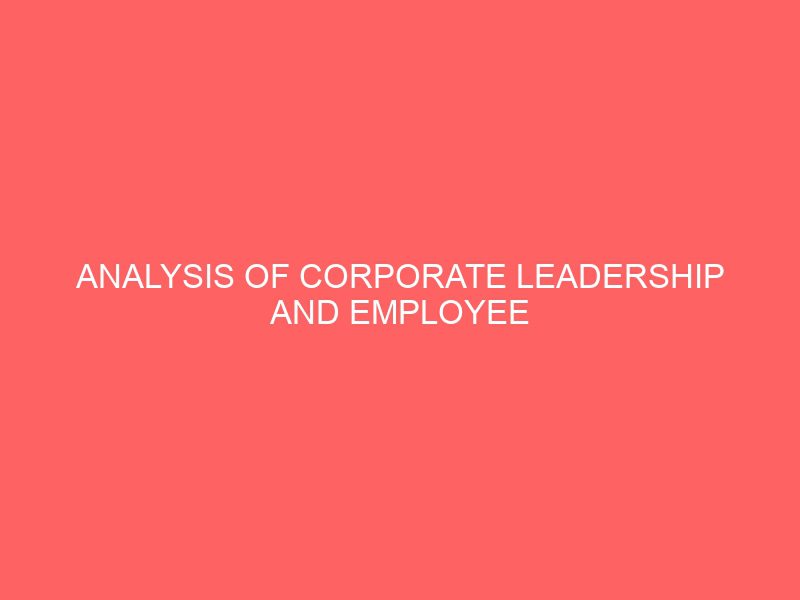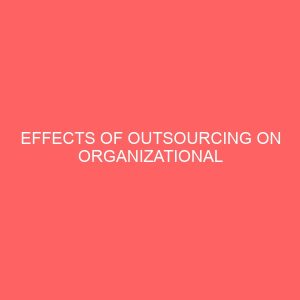Description
INTRODUCTION Leadership is a subject that has long excited interest among scholars and managers of men and resources. The term connotes images of powerful dynamic persons who command victorious grieves, direct corporate empires from top gleaming skyscraper of shape the course of nation (Yukul 1981). Interest in this subject existed as long as people have been studying human behaviour. In fact leadership behavior arises where two or more persons gather for political, economic, social or religious purpose. Mekeaghar (1997:180) attested that leadership is not the giving of direct, rather it is the facilitation of directedness, it is an activity of a group which cannot actually be separated from the dynamic interaction of the communal process of envisioning. As such, leadership entails responsibility of self and others, not only in the identified leader but also in each member of the group within which leadership implies not only the interrelatedness of persons but also their common direction. In actual fact, leadership is more than power or authority, it actually implies some degree of voluntary compliance by followers. Peters (1991:340) stressed that in today’s business world, leadership is a subject of profound importance and of critical relevance to our day to day activities. The success or failure of enterprises, the ability to support families (and employee families), and a sense of self worth and achievement, all have direct links to the performance of corporate leaders. Leader decisions change companies and lives because leadership is both the adhesive that binds a work group together and the catalyst for employee motivations. The organization that exists today is dramatically different from that which hitherto, existed or which will exist in the future, because technology, the customs have all changed and will continue to change. Today, the market place is global, the customs are more demanding, the capabilities to communicate, especially via the Internet, is growing exponentially. Besides, employees are even withholding their allegiance until incorporated into the decision making process. Leaders recognize that while the fundamental principles by which they do business in changing rapidly (Ferris, 1997). Today, job requires more thinking, more customers services, more initiative and more skills application, physical labour is obviously less required. It is a completely different world requiring different leadership techniques. The leadership as the eyes, ears, heart and soul of the organization constantly scans the emerging changes in the world and redefines the business in order to increase its viability overtime. The approach of leaders is simply a matter of personal style. Some are authocratic, or democratic and many offer a combination of styles. They always like to do anything they want at anytime without consulting anybody while some are democratic, in the sense that they will do anything. Many offer a combination of styles. Most successful corporate leaders adopt the approach that meets the needs of the organization and business structure at hand. At times, the approaches has do overlap. Some select a dominant approach, using it as the compass and ruler that direct all corporate decisions and activities (Farkas and Wetluafer 1996:166). Fem’s (1997:151) is of the view that corporate organization in the past had the top three or four executives,who make all the decision and then supervised the implementation process. But in today’s turbulent world, it is impossible to control from the top. It is unreasonable even to try. This is because today’s business world is highly competitive. The way to survive is to reshape to the need of the rapidly changing world. It is a company does not meet the needs of its competitors with organizations are reshaping themselves to change quickly in order to meet the needs of their customers. Organizations leaders know they cannot throw many act every problem; the needs highly committed and flexible workers. Peters (1991:344) maintain that despite the acceleration technology/authoritative revolution, our organization must become more dependent on people who are responsible for the companies, success than ever before, especially with the front line staff with customers. He emphasizes that this go way beyond, “the people are our greatest asset†statement that appeared in the mission statement in the seventies and eighties. The essence behind today’s deep roofed belief is that in today’s world, technologies and production come and go. Natural resources throughout the planet and commercial power continues to shift from manufacturing to services, therefore the employee plays a vital role in the organizational success. He insists that, there is no limit to what the average person can accomplish if well trained, well supported and well paid for primary source of volume added not a factor of production to be optimized, minimized and/or eliminated. As we are in the 21st century leaders will have to be highly flexible and have a broad range of skills. In order to lead and keep good people, leaders must be articulated, energetic and empowering, modern thinking about power is that more power is gained by empowering others. Successful empowerment will typical require feedback on performance form a variety of sources, an environment that is leant of mistakes, widely distributed information, that is to learnt of mistakes widely distributed information, generalist managers and employees, flat structures and less bureaucracy. In the service industry, managers describe their primary sources of competitive advantages as being the people. As such people are the single most important asset. Only a system of distributed decision making can provide flexibility and motivation for people to maintain peak performance levels. The banking sector being one of the foremost sectors in the services industry was selected for the study. The roles of banks in the macro-economic polities of a nation especially in the implementation of monetary and fiscal policies cannot be over emphasized. Commercial Banks have been selected for this study because of their capital formation role through financial intermediation. Three Commercial Banks in Enugu were selected for this study. They are Eco Bank International Plc, Diamond Bank Limited, Union Bank of Nigeria Plc. These Banks were selected based on their structures, age and size. The study is to assess the leadership styles adopted in the banking industry and the relationship between leadership style and corporate performances, to determine whether the employees are empowered or not and the correlation between employee empowerment and employee performance. It is also aimed at determining the relationship that exists between employee improvement, leadership style and organizational performance and the overall impact on the stakeholders.







